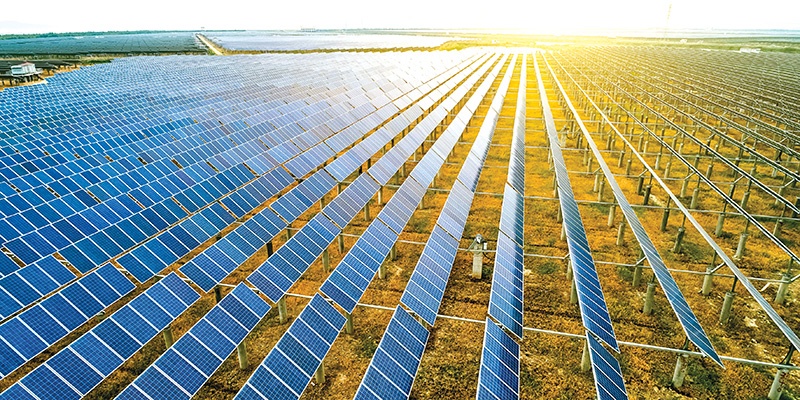Solutions coming thick and fast for draft PDP
 |
| The latest changes to the country’s power plan are adding focus to both solar and wind power Photo: Shutterstock |
The number of registered projects in the wind and solar power sector continues to increase, despite the reductions in power generation in 2021. Bui Quoc Hung, deputy director of the Electricity and Renewable Energy Authority under the Ministry of Industry and Trade (MoIT), said at a press conference on January 12 that the ministry “received many requests from localities about the addition of power projects to the plan (PDP8), especially from those localities with naturally high potential for renewables such as solar and wind.
“The PDP8 cannot meet all requirements of localities,” Hung said. “The huge amount of solar and wind power that has been developed over the past few years can only be used appropriately if supply and demand are met with local load capacity.”
According to Hung, the PDP8 will be calculated and put into distribution in accordance with each region’s requirements. The MoIT is currently revising the plan towards sustainability, devoting major chapters to the development of green, clean, and eco-friendly energy sources at reasonable production costs. This is to ensure the interests of the state, investors, and end-users alike, as well as meeting Vietnam’s commitments to the world on minimising greenhouse gas emissions.
The country’s development of renewable energies has made strides within the last few years. According to data from Electricity of Vietnam, as of October 31 last year, the total installed capacity of renewable energy sources reached over 20,600MW, in which solar, wind, and biomass account for 22.57, 5.16, and 0.28 per cent of the total capacity.
At another press conference on January 9, Deputy Prime Minister Le Van Thanh commented that the draft PDP8 remains plagued with many problems, and many localities continue to ask for additional planning. The previous PDP was expected to include a total capacity of 180,000MW but was then reduced to about 140,000MW. But now, localities and businesses continue to apply for additional planning to supply around 283,000MW.
“I worked with the MoIT in about 20 meetings,” said Thanh. “The electricity planning is a limitation of the industry and trade sector. The management of the power price and the feed-in tariffs remain inadequate and require in-depth research.”
He cited the unreasonable allocation of power, leading to the requirement of a huge investment in the transmission system, possibly using up to $33 billion in the next 10 years. Meanwhile, in the previous decade, only about $12 billion were invested in the system.
The changes in the latest draft moved further in the direction of reducing fossil fuels and increasing the proportion of renewable sources, to contribute to realising the commitment of Prime Minister Pham Minh Chinh at COP26 held in the UK last November to achieve net zero emissions by 2050.
After three revisions, the latest draft from November has reconsidered the balance calculation to ensure energy security with solar power capacity. Thus, the newest draft focuses more on wind power, both onshore and offshore.
The MoIT reconsidered the development of solar power and removed it from the balance calculation due to the limited number of operating hours of approximately four hours a day on average, coupled with the lack of a suitable energy storage system. If solar power is not included, the national backup factor will decrease from more than 69 to 43 per cent, ensuring system safety.
According to a report published by the World Bank, Vietnam can develop 5-10GW of offshore wind power by 2030, generating about $60 billion in added value. Thanks to strong wind sources, such projects could achieve a power factor greater than 50 per cent, equivalent to hydroelectricity. Therefore, wind is one of the key sources of compensation for the power system, as primary energy sources are gradually exhausted.
Dr. Bui Huy Phung from the Vietnam Institute of Energy Sciences said the energy transition process must be balanced in both supply and demand. According to Phung, energy security will be guaranteed if the PDP8 is set out rationally and diversifies the types of power sources.
“Meanwhile, we need to promote the restructuring of economic sectors and industrial production fields that use a lot of energy in the direction of improving efficiency and energy saving. In addition, the government also needs to allow private investors to develop the transmission grid and encouraging businesses to mobilise capital.”
What the stars mean:
★ Poor ★ ★ Promising ★★★ Good ★★★★ Very good ★★★★★ Exceptional
Related Contents
Latest News
More News
- Schaeffler reports strong early output from Dong Nai solar project (December 12, 2025 | 15:16)
- Forestry conference highlights biodiversity and sustainability goals (December 09, 2025 | 13:35)
- Home Credit honoured among top 10 sustainable companies in trade and services (December 09, 2025 | 12:18)
- SCG and seven member companies honoured in Top 100 Sustainable Businesses 2025 (December 08, 2025 | 09:00)
- Nestlé Vietnam pioneers sustainable development and promotes business connections (December 06, 2025 | 12:09)
- CSI 2025 highlights rise of Vietnam’s green champions (December 06, 2025 | 09:00)
- Acecook Vietnam named among top 100 sustainable businesses (December 06, 2025 | 08:00)
- Vietnam’s forest carbon credits draw global interest (December 05, 2025 | 17:41)
- Coro Energy to launch BESS Pilot in Vietnam (December 04, 2025 | 15:12)
- Vietnam strengthens energy storage pathway (December 04, 2025 | 15:05)

 Tag:
Tag:






















 Mobile Version
Mobile Version